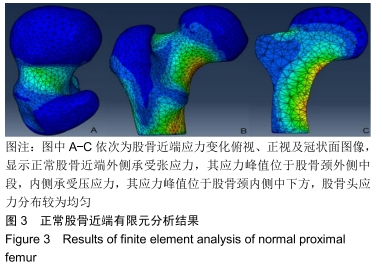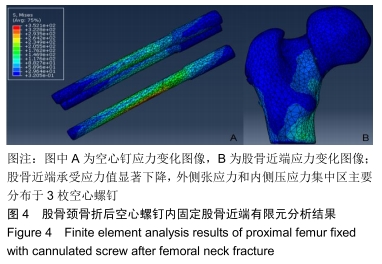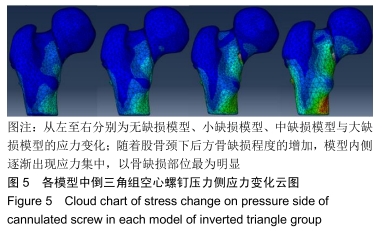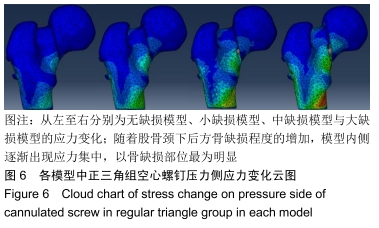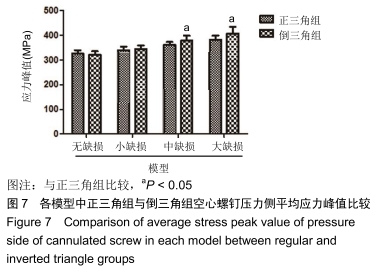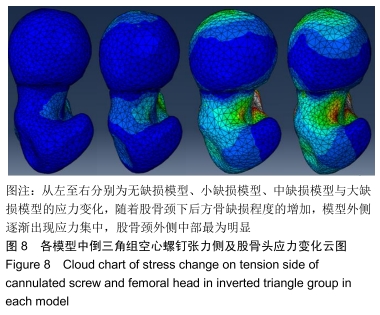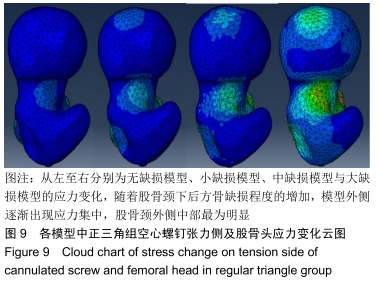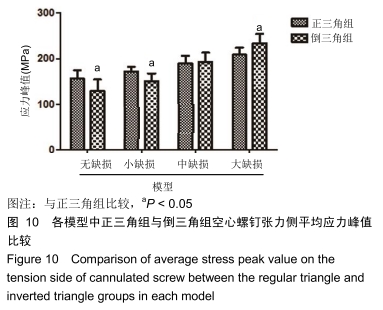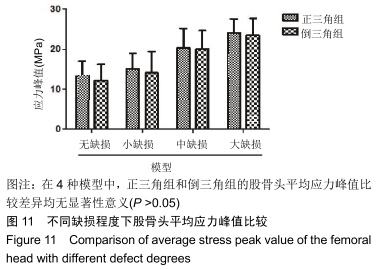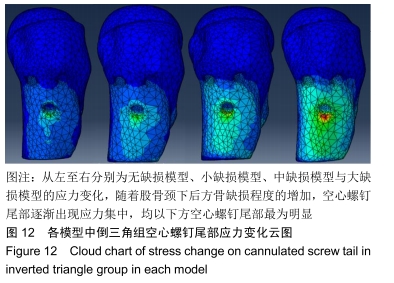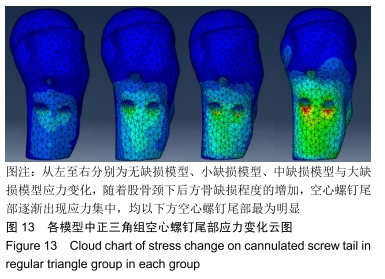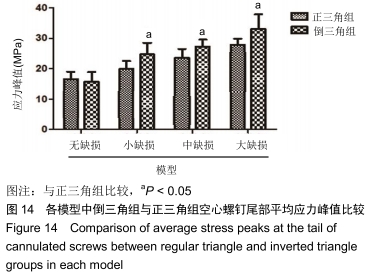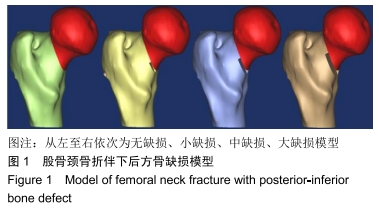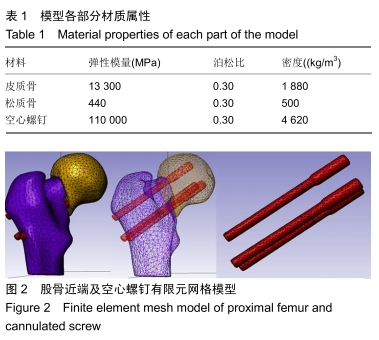中国组织工程研究 ›› 2020, Vol. 24 ›› Issue (18): 2799-2804.doi: 10.3969/j.issn.2095-4344.2623
• 骨与关节生物力学 bone and joint biomechanics • 上一篇 下一篇
有限元分析股骨颈骨折伴下后方不同程度骨缺损空心螺钉内固定后的稳定性
张成宝,余润泽,喻德富,陈 涛,张 彪,沈 政,于 水,许有军,陈 鹏,王少华,徐仲林
- 安徽省第二人民医院骨科,安徽省合肥市 230000
Finite element analysis of femoral neck fracture with different degrees of posterior-inferior bone defect after cannulated screw internal fixation
Zhang Chengbao, Yu Runze, Yu Defu, Chen Tao, Zhang Biao, Shen Zheng, Yu Shui, Xu Youjun, Chen Peng, Wang Shaohua, Xu Zhonglin
- Department of Orthopedics, Anhui Second People’s Hospital, Hefei 230000, Anhui Province, China
摘要:
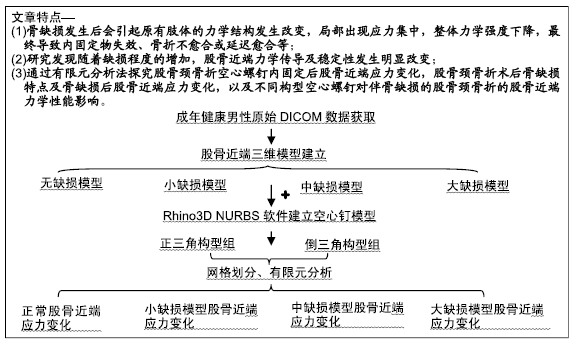
文题释义:
有限元分析:是基于结构力学分析迅速发展起来的一种现代计算方法,通过计算机硬件及软件将载荷、形态、材料结构和力学性能较为复杂的整体划分为有限个简单的单元,进而充分反映整体内外部应力、应变、位移等力学参数的变化情况。通过将股骨近端及空心钉进行有限网格划分,施加载荷后可了解到股骨近端、空心钉每个网格的应力与应变情况。
创伤性股骨头坏死:各类因素引起股骨头血供下降或力学环境改变,导致股骨头内骨小梁坏死塌陷、髋关节疼痛及功能障碍的常见疾病。其中创伤性股骨头坏死与激素性股骨头坏死等不同,生物力学因素在其病情发生发展中发挥重要作用。骨小梁出现“损伤-微骨折-修复”交替反应,超过生理修复负荷,骨小梁修复重塑反应受阻,局部骨小梁走形杂乱无章,这是创伤性股骨头坏死重要的发病机制。
背景:空心螺钉固定为新鲜股骨颈骨折的首选治疗方法,但对于伴有骨缺损的患者,由于股骨近端力学传导及稳定性发生明显改变,易导致内固定物失效、骨折不愈合或延迟愈合等,因此生物力学研究具有重要的临床意义。
目的:利用有限元方法探究骨缺损后股骨近端的生物力学改变,比较不同构型空心螺钉固定内收型股骨颈骨折伴下后方不同程度骨缺损的生物力学效果。
方法:获取一名成年健康男性志愿者股骨近端CT扫描DICOM原始数据,利用MIMICS 10.01软件、Rhino3D NURBS软件制作内收型股骨颈骨折伴后下方不同程度骨缺损模型(无缺损模型、小缺损模型、中缺损模型与大缺损模型),在4组模型中各配置两种构型的空心螺钉(倒三角、正三角),装配完成后进行网格划分、材料属性赋值;通过ABAQUS 6.12软件建立股骨头中心和表面的耦合关系,对所有模型施加缓慢行走时的载荷和约束。
结果与结论:①无缺损模型的股骨颈内侧承受压应力,外侧承受张应力,股骨头应力分布较为均匀,随着股骨颈下后方缺损程度的增加,压力侧和张力侧空心螺钉、空心螺钉尾部及股骨头的应力峰值逐渐上升;②随着缺损程度的增加,空心螺钉压力侧应力峰值逐渐增加,在中、大缺损模型中,倒三角组高于正三角组(P < 0.05),在其余模型中两组之间无差异(P > 0.05);③随着缺损程度的增加,空心螺钉张力侧应力峰值逐渐增加,在无缺损与小缺损模型中,正三角组高于倒三角组(P < 0.05);在大缺损模型中,正三角组低于倒三角组(P < 0.05);在中缺损模型中两组无差异;④随着缺损程度的增加,股骨头应力峰值逐渐增加,3种模型中倒三角组与正三角组均无明显差异(P > 0.05);⑤随着缺损程度的增加,空心螺钉尾部应力峰值逐渐增加,在小、中、大缺损模型中,倒三角组高于正三角组(P < 0.05),在无缺损模型中两组无差异(P > 0.05);⑥结果表明,下后方不同程度骨缺损可显著影响股骨近端力学性能,对于无缺损或缺损程度较小的股骨颈骨折,空心螺钉倒三角构型的生物力学性能优于正三角构型,而对于缺损程度较大的股骨颈骨折,空心螺钉正三角构型的生物力学性能优于倒三角构型。
ORCID: 0000-0001-9190-2904(张成宝)
中国组织工程研究杂志出版内容重点:人工关节;骨植入物;脊柱;骨折;内固定;数字化骨科;组织工程
中图分类号:
